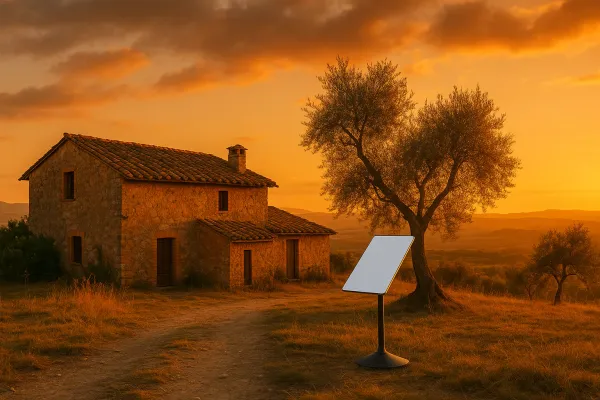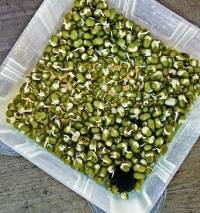Rustic Retreat
Hot Projects
Live broadcasts and documentation from a remote tech outpost in rustic Portugal. Sharing off-grid life, the necessary research & development and the pursuit of life, without centralized infrastructure.
 Subscribe to our new main project Rustic Retreat on the projects own website.
Subscribe to our new main project Rustic Retreat on the projects own website.
Food Hacker? Low on Kitchen estate? Small Budget? Mobile/Ghetto Kitchen? A nomadic Hacker in need of protein rich and vitamin packed food supplement with a very low weight/volume footprint in your backpack, which you can grow on-site? Afraid of the Zombie apocalypse and thinking about solutions for supply needs similar to the nomadic hacker's? Want to personally make a change and stop/reduce eating out-of-local-season import fruit, which would otherwise have to travel up to 12.000 km to get to you but worried about vitamin deficiencies? Try Sprouts.
Sprouts are generally considered as wonder foods. They rank as the freshest and most nutritious of all vegetables available to the human diet. By a process of natural transmutation, sprouted food acquires vastly improved digestibility and nutritional qualities when compared to non-sprouted embryo from which it derives. Sprouted foods have been part of the diet of many ancient races for thousands of years. Even to this day, the Chinese retain their fame for delicious Mung bean sprouts. Nom! Sprouts provide all the essential vitamins and minerals. They should form a vital component of our diet.
You basically just need seeds, water and a containment/growing environment that produces favorable conditions for the process. Nature does the rest. The SEEDStack is a Proposal/Demonstrator for such an open, integrated, modular and stackable containment/growing system. You can just grab the part files or adapt the model to print your own copies with a 3D printer. No heating or lighting is required, in fact, a dark environment produces better yields.
Goals:
After looking at many historic and current commercial implementations, the best elements and ideas were adapted, mashed up and broken down into several modules in order to have the most flexible setup and ease printing.
The Lid covers the topmost container in the stack so that each container is providing a closed section of moist atmosphere to create a favorable sprouting environment. The handle in the middle is actually the CERN OHL (Open Hardware License) Logo, with an added seedling growing from it. It's just a design element depicting how we can use modern open technology, to enable us to go back to basics, like growing food, by ourselves again.
| Print Time | Z resolution | Filament | Length/Volume |
|---|---|---|---|
| ~3 hours | 200 um | PLA | 15.5 m / 37.4 cm³ |
These containers are the main pieces of the set. You can start with just one. When your circumstances require more harvest volume, you can simply print more of these containers and stack them on top of each other to a tower.
This design approach reduces the necessary surface area for a seedstack and scales beautifully from just one to a whole set of containers, which can contain different seeds but all get flushed and fresh water automagically via the built-in auto-draining feature.
Checkout the following Video to see the delayed auto-drain in action. The container takes on a certain amount of water before actually starting to flush the water and then automatically drains itself completely, leaving only less than 1mm of waterlevel to keep the atmosphere moist and the seeds above on the spacing grid.
The key feature of the auto-drain is the tube in the container and the following part which, once in place, turns the tube into a siphon. As long as the water level is not high enough to reach the end of the tube, it cannot escape the container. Once it has flown over, the falling water (gravity) creates suction in the siphon and continues to drain water from the container until the water level reaches the bottom of the inner tube of the siphon. Then it starts to pull air and the process terminates automatically. If you need different water/retain levels, you can simply change the height of the container- and siphon-tube respectively.
module syphon()
{
difference()
{
union()
{
// Outer Skirt
difference()
{
translate([0,0,syphon_skirt_height/2])cylinder(h=syphon_skirt_height, d1=syphon_skirt_outer_d, d2=syphon_tip_outer_d, center=true);
union()
{
translate([0,0,syphon_skirt_height/2-0.1])cylinder(h=syphon_skirt_height+0.1, d1=syphon_skirt_outer_d-2, d2=syphon_tip_outer_d-1, center=true);
for(x=[0:45:360])
{
rotate([0,0,x])translate([9,0,0])cube(size=[5,1,15],center=true);
}
translate([0,0,syphon_skirt_height/2+syphon_tip_height/2])cylinder(h=drain_h,d=syphon_tube_inner_d, center=true);
}
}
// Inner Tube
difference()
{
translate([0,0,syphon_skirt_height/2+syphon_tip_height/2])cylinder(h=syphon_skirt_height+syphon_tip_height,d=syphon_tube_outer_d, center=true);
translate([0,0,syphon_skirt_height/2+syphon_tip_height/2-1])cylinder(h=drain_h+7,d=syphon_tube_inner_d, center=true);
}
// Tube Guides
for(x=[0:120:360])
{
rotate([0,0,x])translate([4.5,0,drain_h])cylinder(h=drain_h+3,d=stg_d,center=true);
}
}
// Bottom Cuts
translate([0,0,-syphon_skirt_height/2+1.1])rotate([90,0,0])cylinder(h=syphon_skirt_height+syphon_tip_height,d=syphon_tube_inner_d, center=true);
translate([0,0,-syphon_skirt_height/2+1.1])rotate([90,0,90])cylinder(h=syphon_skirt_height+syphon_tip_height,d=syphon_tube_inner_d, center=true);
}
}
| Print Time | Z resolution | Filament | Length/Volume |
|---|---|---|---|
| ~18 Minutes | 200 um | PLA | 0.35 m / 0.85 cm³ |
In Progress…
Mung seeds have been selected as the first test candidate because they don't require to be cooked in order to become edible (some sprouts do), offer a great range of vitamins and minerals and should be easily obtainable everywhere.
| A | B1 | B2 | B3 | B5 | B6 | B9 | B12 | C | D | E | K | Protein | Minerals |
|---|---|---|---|---|---|---|---|---|---|---|---|---|---|
| X | X | X | X | X | X | X | - | X | - | X | - | 25% | Fe, Ca, P,Mg, Mn, Na, Se, Cu |
The seeds have been completely submerged in room temperature tap water for about 8 hours in a cup, then put into the seedstack container. The seeds will sprout without this step, however, giving the seeds 8 hours in water seems to have an effect on the overall mass the sprouts will yield.
After putting the seeds into the seedstack container, they need to be flushed twice per day (morning/evening). To flush the seeds, about 500ml of water are poured in the topmost container (if you have more than one) and will drain automatically at the bottom of the container. This might also be a good job for an Arduino controlled valve/pump.
 The siphon was changed to the new printed (black) one and flushed again. Siphon operation test successfully concluded, almost all seeds have cracked their shell and begun to sprout already.
The siphon was changed to the new printed (black) one and flushed again. Siphon operation test successfully concluded, almost all seeds have cracked their shell and begun to sprout already.
Anyone interested is of course also invited to download the model and play/use/verify/optimize as well. Feedback, PR's and everything else that might improve usability, features and safety are welcome:
Can/should you put/grow food in something you made with a 3D Printer?
Without further open, transparent and long-term study, it's hard to come up with a more definitive answer but when we look at industrial food containers and some of the more recent issues about migration of plastic components or additives - mostly phthalates (PAEs), alkylphenols (APs), 2,2-bis(4-hydroxyphenyl)propane (bisphenol A or BPA) and di(2-ethylhexyl)adipate (DEHA) - we have a couple of available 3D printing material choices:
In both cases, a full stainless-steel hot-end is also recommended, to eliminate potential lead traces introduced by a brass nozzle and to make it a habit to have a conscious disinfection/cleaning/drying step in your post-harvest workflow to reduce bacteria build up before put into storage until used again.
Why not just use $ware Containers?
DIY 3D printing is already beginning to leverage this situation. Today we can just share parametric projects and change a couple of numbers in a file for basic changes or have the freedom to copy, remix, adapt and extend everything as we like and share that with the rest again on github.com or platforms like http://www.thingiverse.com.
As all emerging revolutionary technologies before, like the Internet or mobile communication, 3D printing is still in its Kindergartenphase, where we have to play and learn what this technology will enable us to do in the long run, like the early days on the net, when we never had a clue how big the Internet would grow and how far it would exceed our wildest dreams of connecting and sharing our ideas and solutions with everyone in real-time.
In the early days we still used the Internet as a mere extension for our ego where we could show what we have done and how cool that makes us to a broad audience. With better cams and more and more people changing their MO away from themselves and towards HOW we are doing things, so that others could benefit from the confidence that it obviously can be done as well as free information how exactly it was done so that others may just copy and build upon it. Videos made the transfer even easier.
Now we start being able to produce the things we need on a very individual level with almost no considerable bootstrapping time. If we can go to Amazon and have them build anything exactly to our requirements and deliver within 24 hours for a fair price: Awesome. Until then: On-Site 3D Printing FTW. The 3D printer market is expected to grow from 100,000 units in 2014 to about six million units in 2018, Digitimes reported referring to the Industrial Economics & Knowledge Center (IEK) under Taiwan's Industrial Technology Research Institute.
We have basically achieved what probably has inspired most Star-Trek fans too: A system (the computer) we can ask any question and get a broad scope of possible answers to make up our own mind about it (Internet) and now: Replicators. They might not work even close to real-time yet, but who cares? Never forget: It's not your time. You can do something else in the time it takes a 3D printer to produce the thing you've tasked it to print.
Does sprouting increase the nutritional value?
Journal of Food Science (1975), 40(5), 1008-9 CODEN: JFDSAZ; ISSN: 0022-1147. English. Dry seeds and sprouts of Alfalfa, Lentils, Mung and Soy Beans were analyzed for selected nutrients. Sprouts compared on a solids basis contained Ca [7440-70-2], Fe [7439-89-6], and Zn [7440-66-6] at levels about the same as the seeds while protein was higher and fat content lower in sprouts. Total vitamin C [50-81-7], thiamine [59-43-8], niacin [59-67-6] and riboflavin [83-88-5] content was higher in sprouts than seeds, vitamin C showing the greatest increase. Cooking slightly lowered heat-labile nutrients. Galactose-containing sugars of Mung beans disappeared upon sprouting. Based upon chem. analyses, nutrient levels of sprouts compare favorably with other fresh vegetables.